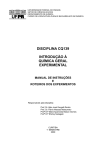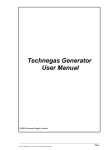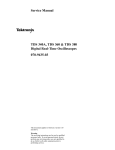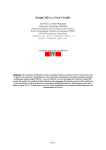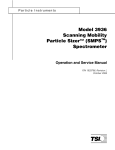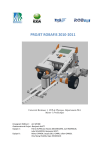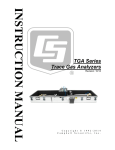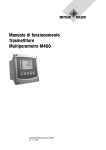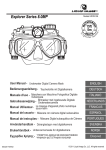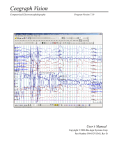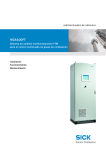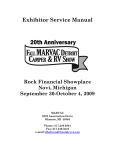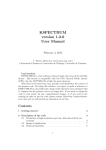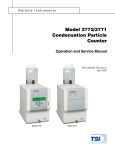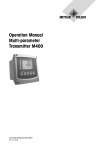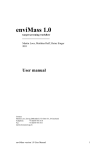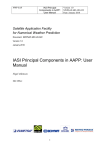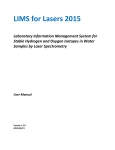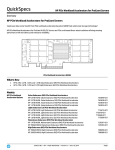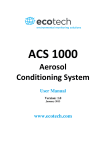Download Manual - Ecotech
Transcript
Spectronus Trace Gas & Isotopes Analyser User Manual Version: 3.10 www.ecotech.com Sp ec tr on u s U ser M an u a l 3. 10 This page is intentionally blank Page 2 Table of Contents Manufacturer’s Statement ................................................................................................................................................ 7 Notice.. .............................................................................................................................................................................. 7 Safety Requirements ......................................................................................................................................................... 8 Warranty............................................................................................................................................................................ 9 Service and Repairs ............................................................................................................................................................ 9 CE Mark Declaration of Conformity ................................................................................................................................. 10 Claims for Damaged Shipments and Shipping Discrepancies .......................................................................................... 11 Internationally Recognised Symbols on Ecotech Equipment ........................................................................................... 12 Manual Revision History .................................................................................................................................................. 13 1. 2. 3. Introduction .................................................................................................................................... 14 1.1 Description .......................................................................................................................................................... 14 1.2 Specifications ...................................................................................................................................................... 14 1.2.1 Measurement ...................................................................................................................................... 14 1.2.2 Power................................................................................................................................................... 15 1.2.3 Operating Conditions ........................................................................................................................... 16 1.2.4 Physical Dimensions............................................................................................................................. 16 1.2.5 External Connections ........................................................................................................................... 17 1.3 Instrument Subsystems ....................................................................................................................................... 18 Hardware Reference....................................................................................................................... 19 2.1 Closed Path Analyser ........................................................................................................................................... 19 2.2 Components ........................................................................................................................................................ 20 2.2.1 Optics & Cell ........................................................................................................................................ 20 2.2.2 Gas Handling System ........................................................................................................................... 20 2.2.3 Computer & Password ......................................................................................................................... 23 2.2.4 Internal and External Connections....................................................................................................... 23 2.2.5 Thermostat & Enclosure ...................................................................................................................... 25 2.3 Installation........................................................................................................................................................... 27 2.3.1 Instrument Externals Overview ........................................................................................................... 27 2.3.2 Un-packing and Shipping. .................................................................................................................... 27 2.3.3 Power Connection ............................................................................................................................... 29 2.3.4 Pneumatic Connectors ......................................................................................................................... 29 2.3.5 Front Panel Connections ...................................................................................................................... 30 2.3.6 Set-up .................................................................................................................................................. 32 2.3.7 Chemical Dryer Filling and Connection ................................................................................................ 34 2.3.8 Power-up ............................................................................................................................................. 36 2.3.9 Power-down ........................................................................................................................................ 36 Software Quick Start Guide ............................................................................................................ 37 3.1.1 3.1.2 3.1.3 4. Software Start-up ................................................................................................................................ 37 Spectronus Workspace and Software Manual ..................................................................................... 38 Software parts ..................................................................................................................................... 38 Sampling ......................................................................................................................................... 41 4.1 Starting Sampling ................................................................................................................................................ 41 Spectronus User Manual 3.10 Page 3 Sp ec tr on u s U ser M an u a l 3. 10 4.2 5. Background Spectrum......................................................................................................................................... 41 Maintenance .................................................................................................................................. 42 5.1.1 5.1.2 5.1.3 5.1.4 5.1.5 5.1.6 5.1.7 5.1.8 5.1.9 5.1.10 5.1.11 5.1.12 5.1.13 5.1.14 5.1.15 5.1.16 5.1.17 5.1.18 5.1.19 6. 7. 8. Precision Checks .................................................................................................................................. 42 FTIR Spectrometer............................................................................................................................... 42 Files ..................................................................................................................................................... 42 Gas Cell ................................................................................................................................................ 42 Chemical Dryer Refill ........................................................................................................................... 43 Partical Filter Element Replacement ................................................................................................... 43 Pump ................................................................................................................................................... 44 Leak Check........................................................................................................................................... 44 Opening the Middle (Optics & Cell) Enclosure Side Panel ................................................................... 45 Opening the Middle (Optics & Cell) Enclosure Rear Panel .................................................................. 47 Cell Isolation Valves............................................................................................................................. 48 Opening the Lower/Plumbing Section Door........................................................................................ 49 Checking & Adjusting the MFC Zero Pots ............................................................................................ 50 OPUS Status Indicators ........................................................................................................................ 52 Running the OPUS OVP ....................................................................................................................... 52 OPUS – Abort Task .............................................................................................................................. 56 Spare Parts List .................................................................................................................................... 56 Safety .................................................................................................................................................. 56 Cleaning............................................................................................................................................... 57 Calibration...................................................................................................................................... 59 6.1 Sensor Calibration ............................................................................................................................................... 59 6.2 Calibration of FTIR Mole Fraction Measurements .............................................................................................. 60 6.2.1 Quantitative Spectrum Analysis: MALT ............................................................................................... 60 6.2.2 Calibration Overview ........................................................................................................................... 60 6.2.3 General Calibration Considerations .................................................................................................... 61 6.2.4 Correction to Dry Air Mole Fraction .................................................................................................... 61 6.2.5 Cross Sensitivity Corrections ............................................................................................................... 61 6.2.6 Calibration to a Reference Scale ......................................................................................................... 62 6.2.7 Isotopic Calibration ............................................................................................................................. 63 6.2.8 Calibration Summary ........................................................................................................................... 65 6.3 Determining Cross Sensitivities .......................................................................................................................... 67 6.3.1 Water Vapour & CO2 ........................................................................................................................... 67 6.3.2 Pressure .............................................................................................................................................. 69 6.3.3 Temperature ....................................................................................................................................... 69 6.3.4 Typical Cross Sensitivity Coefficients ................................................................................................... 69 6.3.5 Stripping Water Vapour & CO2 Absorption Features from Background Spectra ................................. 70 6.3.6 Analysis of the Problem....................................................................................................................... 70 6.3.7 Procedure Outline ............................................................................................................................... 70 6.3.8 Example ............................................................................................................................................... 71 6.3.9 In Practice............................................................................................................................................ 73 6.3.10 Imperfect Cancellation of Water Vapour Absorption Features ........................................................... 73 Signal to Noise Ratios and Allan Variance ..................................................................................... 75 7.1 Signal to Noise Ratio (SNR) ................................................................................................................................. 75 7.2 Allan Variance ..................................................................................................................................................... 75 References ..................................................................................................................................... 79 Page 4 List of Figures Figure 1 – FTIR – Spectrometer and glass cell ....................................................................................................... 19 Figure 2 – FTIR – Transfer optics detail ................................................................................................................. 19 Figure 3 – Gas handling system flow diagram ....................................................................................................... 22 Figure 4 – Bruker LAN TCP/IP properties............................................................................................................... 24 Figure 5 – TE cooler ............................................................................................................................................... 25 Figure 6 – Overview of the analyser ...................................................................................................................... 27 Figure 7 – Removing cooler/heater shipping protection ...................................................................................... 28 Figure 8 – Removing the front panel shipping protection..................................................................................... 28 Figure 9 – Front panel lower and middle section connections ............................................................................. 30 Figure 10 – Front panel lower section pin out ...................................................................................................... 31 Figure 11 – Front panel upper section/computer connections ............................................................................. 32 Figure 12 – Nitrogen purge flow set to ~150cc/m ................................................................................................. 33 Figure 13 – Magnesium perchlorate dryer ............................................................................................................ 35 Figure 14 – Windows close button - X ................................................................................................................... 36 Figure 15 – Windows 7 Task Bar............................................................................................................................ 37 Figure 16 – OPUS No Active Task .......................................................................................................................... 37 Figure 17 – Spectronus help/manual .................................................................................................................... 38 Figure 18 – Spectronus workspace ........................................................................................................................ 39 Figure 19 – Software flow diagram ....................................................................................................................... 40 Figure 20 – Removable panels on left-hand side. ................................................................................................. 46 Figure 21 – Middle section panel open. ................................................................................................................ 47 Figure 22 – Middle section rear panel. .................................................................................................................. 47 Figure 23 – Cell end, isolation valves and temperature sensor ............................................................................. 48 Figure 24 – Lower (plumbing) section door opened ............................................................................................. 49 Figure 25 – Lower/plumbing section layout .......................................................................................................... 50 Figure 26 – MFC Zero adjust pot ........................................................................................................................... 50 Figure 27 – OPUS – instrument status ................................................................................................................... 52 Figure 28 – OPUS – setup OVP .............................................................................................................................. 53 Figure 29 – OPUS – OVP test setup ....................................................................................................................... 53 Figure 30 – OPUS – PQ and OQ test protocol ........................................................................................................ 54 Figure 31 – OPUS – run OVP tests ......................................................................................................................... 55 Figure 32 – OPUS – Abort Task .............................................................................................................................. 56 Figure 33 – Flow splitter for determining cross-sensitivities to water vapour and CO2 ........................................ 67 Figure 34 – Measurement: Stepwise stripping of CO 2 for CO2 cross-sensitivity – time series of raw retrieved mole fractions ..................................................................................................................... 68 Figure 35 – Measurement: Stepwise stripping of CO 2 for CO2 cross-sensitivity – regressions of trace gas 13 mole fractions and δ C against CO2 mole fraction ............................................................................ 68 Figure 36 – CO2 retrieval – strong water vapour absorption ................................................................................. 71 Figure 37 – Original background spectrum of an evacuated cell (blue) and the stripped spectrum (red) in -1 the 3600 cm region where there is strong water vapour absorption .............................................. 73 Figure 38 – Allan-Variance plot of N2O .................................................................................................................. 75 Figure 39 – Allan-Variance plot of CO ................................................................................................................... 76 Spectronus User Manual 3.10 Page 5 Sp ec tr on u s U ser M an u a l 3. 10 List of Tables Table 1 – Manual revision history .......................................................................................................................... 13 Table 2 – Examples of valve switching states for various functions ...................................................................... 21 Table 3 – HITRAN isotopologue abundances for CO2 ............................................................................................ 63 Table 4 – Typical cross-sensitivities for target gases to water vapour and pressure ............................................ 69 Table 5 – 1 σ repeatability for 1 and 10-minute averaging times for a typical FTIR trace gas analyser ................ 77 Page 6 Manufacturer’s Statement Thank you for selecting the Ecotech Spectronus Trace Gas & Isotopes Analyser. The analyser uses Fourier transform infrared (FTIR) spectroscopy to quantify the mixing ratios of several trace gas species (including CO2, N2O, CH4, CO, H2O, as well as δ13C in CO2 and optionally δD in H2O vapour). When used in conjunction with micrometeorological and chamber systems it can be used to estimate the fluxes of these gases to and from the atmosphere [Citation: 8.5 ]. This User Manual provides a complete product description including operating instructions, calibration, and maintenance requirements for the Spectronus. Reference should also be made to the relevant local standards, which should be used in conjunction with this manual. Some relevant standards are listed in the References section of this manual. If, after reading this manual you have any questions or you are still unsure or unclear on any part of the Spectronus then please do not hesitate to contact Ecotech or your local Ecotech distributor. Please help the environment and recycle any printed pages of this manual when finished using it. Notice The information contained in this manual is subject to change without notice. Ecotech reserves the right to make changes to equipment construction, design, specifications and/or procedures without notice. Copyright © 2013. All rights reserved. Reproduction of this manual, in any form, is prohibited without the written consent of Ecotech Pty Ltd. Spectronus User Manual 3.10 Page 7 Sp ec tr on u s U ser M an u a l 3. 10 Safety Requirements To reduce the risk of personal injury caused by electrical shock, follow all safety notices and warnings in this documentation. If the equipment is used for purposes not specified by Ecotech, the protection provided by this equipment may be impaired. The safety of any system incorporating the equipment is the responsibility of the assembler of the system. Replacement of any part should only be carried out by qualified personnel, using only parts specified by Ecotech as these parts meet stringent Ecotech quality assurance standards. Always disconnect the power source before removing or replacing any components. CAUTION Hazardous voltages exist within the analyser. All analyser panels should be closed and secured when the analyser is connected to the mains power. Ensure the power cord is maintained in a safe working condition. CAUTION – magnesium perchlorate The chemical dryer should be filled with magnesium perchlorate supplied by the user. Magnesium perchlorate is a hazardous substance that has particular safety and shipping requirements and is not allowed on an aircraft. The user must obtain and adhere to the directions from the supplier’s material safety data sheet (MSDS) for magnesium perchlorate. The user must not ship the magnesium perchlorate dryer with the instrument. CAUTION – Heavy The analyser is heavy and should not be manually lifted. It should only be lifted by an appropriate mechanical lifting aid, such as a fork lift. CAUTION Laser radiation exists within the IRCUBE. Never look directly into the laser beam, or use any kind of optical instruments to look into the beam as this may cause permanent eye damage. Please refer to the IRCUBE manual. Page 8 Warranty This product has been manufactured in an ISO 9001/ISO 14001 facility with care and attention to quality. The product is subject to a 12 month warranty on parts and labour from date of shipment (the warranty period). The warranty period commences when the product is shipped from the factory. Lamps, fuses, batteries and consumable items are not covered by this warranty. Each analyser is subjected to a vigorous testing procedure prior to despatch and will be accompanied with a test results for Allan Variance, Cross-Sensitivities and Multipoint Calibration thereby enabling the analyser to be installed and ready for use without any further testing. Service and Repairs Our qualified and experienced technicians are available to provide fast and friendly service between the hours of 8:30am – 5:00pm AEST Monday to Friday. You are welcome to speak to a service technician regarding any questions you have about your analyser. Service Guidelines In the first instance, please call or email us if you are experiencing any problems or issues with your analyser. If you are within Australia or New Zealand please contact our service response centre via email on [email protected] or call +61 (0)3 9730 7800 If outside of Australia and New Zealand please email our international support department at [email protected] or call +61 (0)3 9730 7800 If we cannot resolve the problem through technical support, please email the following information: Name and phone number Company name Shipping address Quantity of items being returned Model number/s or a description of each item Serial number/s of each item (if applicable) A description of the problem Original sales order or invoice number related to the equipment When you email us we will assign a Return Material Authorisation (RMA) number to your shipment and initiate the necessary paperwork to process your equipment within 48 hours. Please include this RMA number when you return equipment, preferably both inside and outside the shipping packaging. This will ensure you receive prompt service. Spectronus User Manual 3.10 Page 9 Sp ec tr on u s U ser M an u a l 3. 10 CE Mark Declaration of Conformity This declaration applies to the Spectronus Trace Gas and Isotopes Analyser as manufactured by Ecotech Pty. Ltd. of 1492 Ferntree Gully Rd, Knoxfield, VIC, 3180, Australia, and which may be sold in the following configurations: Part Number Description E080001 Spectronus Trace Gas and Isotopes Analyser To which this declaration relates is in conformity with the following European Union Directives: Council Directive of 15 December 2004 on the approximation of the laws of Member States relating to electromagnetic compatibility (2004/108/EC) The following standard was applied: EN 61326-1:2013 Electrical equipment for measurement, control and laboratory use – EMC Requirements – Part 1: General requirements. Immunity Requirements EN 61326-1 IEC-61000-4-2 Electrostatic discharge immunity IEC-61000-4-3 Radiated RF immunity IEC-61000-4-4 Electrical fast transient burst immunity IEC-61000-4-5 Surge immunity IEC-61000-4-6 Conducted RF immunity IEC-61000-4-11 Voltage dips and interruption immunity Electromagnetic compatibility EN 61326-1 CISPR-11 Radiated RF emission measurements CISPR-11 Mains terminal RF emission measurements IEC-61000-3-3 Mains terminal voltage fluctuation measurements IEC-61000-3-2 Power frequency harmonic measurements Council Directive of 12 December 2006 on the harmonisation of the laws of Member States relating to electrical equipment designed for use within certain voltage limits (2006/95/EC) The following standard was applied: EN 61010-1:2013 Safety requirements for electrical equipment, for measurement control and laboratory use (3rd edition) – Part 1: General requirements For protection against: Electric shock or burn Mechanical HAZARDS Excessive temperature Spread of fire from the equipment Effects of radiation, including laser sources and sonic and ultrasonic pressure Page 10 Claims for Damaged Shipments and Shipping Discrepancies Damaged Shipments Inspect all instruments thoroughly on receipt. Check materials in the container/s against the enclosed packing list. If the contents are damaged and/or the instrument fails to operate properly, notify the carrier and Ecotech immediately. The following documents are necessary to support claims: Original freight bill and bill of lading Original invoice or photocopy of original invoice Copy of packing list Photographs of damaged equipment and container You may want to keep a copy of these documents for your records Please refer to the instrument name, model number, serial number, sales order number, and your purchase order number on all claims. You should also: Contact your freight forwarder for an insurance claim Retain packing material for insurance inspection Shipping Discrepancies Check all packages against the packing list immediately on receipt. If a shortage or other discrepancy is found, notify the carrier and Ecotech immediately. We will not be responsible for shortages against the packing list unless they are reported promptly (within 7 days). Contact Details Head Office 1492 Ferntree Gully Road, Knoxfield VIC Australia 3180 Phone: +61 (0)3 9730 7800 Fax: +61 (0)3 9730 7899 Email: [email protected] Service: [email protected] International Support: [email protected] www.ecotech.com Spectronus User Manual 3.10 Page 11 Sp ec tr on u s U ser M an u a l 3. 10 Internationally Recognised Symbols on Ecotech Equipment Page 12 On (Supply) IEC 417, No. 5007 Off (Supply) IEC 417, No. 5008 Electrical fuse IEC 60417-5016 Earth (ground) terminal IEC 60417-5017 Protective conductor terminal IEC 60417-5017 Alternating current IEC 60417-5032 Caution, hot surface IEC 60417-5041 Caution, risk of danger. Refer to accompanying documents ISO 7000-0434 Caution, risk of electric shock ISO 3864-5036 Manual Revision History Manual PN: M010042 Current revision: 3.10 Date released: 4 November 2013 Description: User Manual for the Spectronus Trace Gas & Isotopes Analyser This manual is the full user manual for the Spectronus Trace Gas & Isotopes Analyser. This manual contains all relevant information on theory, specifications, installation, operation, maintenance and calibration. Any information that cannot be found within this manual can be obtained by contacting Ecotech. Table 1 – Manual revision history Edition Date Summary 3.4 Nov 2011 First release of Ecotech manual 3.5 July 2012 Changed file and path names and screenshots and plumbing diagram and analog input numbers and pictures 3.6 Sep 2012 Changed references from OPUS 6.5 to OPUS 7 and Spectronus 9.0.5 3.6 Sep 2012 110V version, Analysis time from 15 to 20s (4 windows), 2 MFC updates, Software supplied, CSV files, Initial Start-up, 4-20mA input description corrected. Sections references cross-referenced 3.7 March 2013 Changed equation numbering. nd Added spare parts section 3.8 May 2013 Added more spare parts. Re-arranged order of sections. Updated plumbing and software diagrams. Added precision checks, leak check, MFC Zero check & adjust, opening the case sections. Changed Analysis time from 20 to 13s (MALT 5.2.2) 3.9 July 2013 Added warnings to remove magnesium perchlorate before shipping. Removed most second person references. dXdP cycle description. Removed optional last ¼ powder dryer, now all granules. Added correct to dry air in ppm equation 3.10 October 2013 Manual part #, Windows 7, new hardware, separation of hardware and v10 software manual. Quick-connectors explained. OPUS OVP description added. CE compliance Spectronus User Manual 3.10 Page 13 Sp ec tr on u s U ser M an u a l 3. 10 1. Introduction 1.1 Description This document contains information about the operation, construction and technical details of the Ecotech Trace Gas & Isotopes Analyser. This analyser has been developed by the Centre for Atmospheric Chemistry at the University of Wollongong and manufactured by Ecotech Pty Ltd. The analyser uses Fourier transform infrared (FTIR) spectroscopy to quantify the mole fractions of several trace gas species (including CO2, N2O, CH4, CO, H2O, as well as δ13C in CO2 and optionally δD in H2O vapour). When used in conjunction with micrometeorological and chamber systems it can be used to estimate the fluxes of these gases to and from the atmosphere [Citation 8.5]. Throughout this document it is assumed that the user is familiar with basic principles of infrared spectroscopy, specifically FTIR spectroscopy, and if required, the methods used to determine trace gas exchange fluxes at the earth’s surface. The primary purpose of this document is to provide a user guide and technical manual of the system components and their interconnection to facilitate the orientation of new users to system operation. 1.2 Specifications 1.2.1 Measurement Gases Precision (5 min average) CO2 /ppmv 0.04 CH4 /ppbv 0.2 N2O/ppbv < 0.06 CO/ppbv 0.2 δ13C-CO2/‰ < 0.08* δD in H2O vapour/‰ <1 δ13C-in-CO2 precision is compromised if sample airstream is not dried. 15 second to 60 minute time-averaged measurement of all species simultaneously (trade precision for measurement time). Accuracy: 1-5% absolute without reference to any calibration gases. Accuracy is comparable to precision if measurements are referenced to standard calibration gases (NIST, CMDL, GASLAB etc.) [Citation: 8.7]. Page 14 Linearity Better than 0.1% Sample Flow Rate 0.5 – 1.5 SLPM, or static Calibration Drift Typically < precision figure per week [Citation: 8.7] 1.2.2 Power CAUTION The user must ensure that the local mains power matches the power setting as indicated by the factory fitted label below the mains power inlet. If a user needs to change the mains input voltage on the analyser, they should contact Ecotech to discuss. Input Voltage 200 – 240VAC, 50Hz (100 – 120VAC, 60Hz optional) Fuse Rating 5A 20x5 time delay 250VAC Power Consumption Max at 240VAC FTIR (including the heater/cooler) 650VA Max 540W Max Power Consumption Typical at 240VAC, Cell Temp. 30°C, Room Temp. 25°C. FTIR (including the heater/cooler), after warm up 270VA, 200W Spectronus User Manual 3.10 Page 15 Sp ec tr on u s U ser M an u a l 3. 10 Pump 307W, 597VA, 2.44A Note: The pump may draw more power depending on the flow configurations. 1.2.3 Operating Conditions Ambient Temperature Range 10 – 40°C and stable. Refer to Section 2.2.5 - Thermostat & Enclosure for more detail. Altitude Up to 3000 meters above sea level. Sample Temperature 30°C factory configured. Note: Changing the sample temperature may affect all background, calibration, cross sensitivities and measurements. It is recommended to leave this at 30°C. Sample Inlet Pressure Sample inlet pressure should not exceed 1080mBar. Cell Pressure The cell pressure should not exceed 1080mBar, as this is the maximum inlet pressure of the vacuum pump. CAUTION Under certain uses or manual mode, the sample inlet pressure could be passed through entirely to the cell pressure. The user should prevent this occurring, or use a maximum sample inlet pressure of 1080mB. 1.2.4 Physical Dimensions Case Dimensions 1163 mm L x 486 mm W x 885 mm H. Weight Spectronus 120kg Pump 17kg Accessories (Standard) 5kg Page 16 1.2.5 External Connections Computer Interface 3 x USB, 1 x TCIP, 1 x RS232, 1 x RS485, 1 x HDMI. Analog Inputs 3 x Analog input sockets (AI6 – AI8) Voltage range -5V to + 5V DC (Includes +24V auxiliary supply. 500mA per socket) Analog Outputs 2 x Analog output sockets (AO3 – AO4) Voltage range 0 – 5V DC Maximum load 20mA (Includes +24V auxiliary supply. 500mA per socket) Digital Outputs 3 x Digital (relay) output sockets (DO10 – DO12) Contact rating 30V DC, 500mA each (Includes +24V auxiliary supply. 500mA per socket) Spectronus User Manual 3.10 Page 17 Sp ec tr on u s U ser M an u a l 3. 10 1.3 Instrument Subsystems The Spectronus FTIR Trace Gas Analyser is used to determine simultaneously the concentrations of several trace gases in air or other gas streams by collecting and analysing the Fourier transform infrared (FTIR) spectrum of the gas sample. In the closed path trace gas analyser the air is contained in a sample cell which is multi-passed by the IR beam. The analyser consists of separate subsystems under the control of a single computer program: The sample handling subsystem, which carries out all sample handling, inlet sample stream selection, cell evacuation and flushing procedures. This includes a 12-channel digital IO switching capability for switching 12 (or optionally more) solenoid valves, and also 8 channel analog-digital converter for logging environmental variables such as temperatures, pressures and flows. The FTIR spectrometer, which produces and records the interferogram and then performs Fourier transformation in order to obtain the infrared spectrum of sampled air. This Spectrometer is a Bruker IR cube fitted with a thermoelectrically-cooled MCT (Mercury Cadmium Telluride) detector (wavenumber range 2000 -7800cm-1). The IR cube is coupled to a 24 metre multipass gas cell that contains the air to be analysed. The spectrum analyser, which provides quantitative analysis of measured spectra immediately after collection, with real-time display. Logging of analysed concentrations, analysis parameters and analog input quantities to a SQLite database, optionally exported to a comma separated values (CSV) text file. Page 18 2. Hardware Reference This chapter describes the hardware construction and set-up of the closed path analysers. Individual analyser systems may vary in minor detail. 2.1 Closed Path Analyser The closed path FTIR analyser can be divided into several sub-systems: The optical system, including FTIR spectrometer, White cell and detector The gas handling system, including solenoid valves, Nafion and magnesium perchlorate dryers, flow meter and particle filter The embedded computer running Spectronus and OPUS software on Windows The analog input and digital output modules for data logging and solenoid control The thermostat housing to keep the optical system at constant temperature Figure 1 – FTIR – Spectrometer and glass cell Figure 2 – FTIR – Transfer optics detail Spectronus User Manual 3.10 Page 19 Sp ec tr on u s U ser M an u a l 3. 10 2.2 2.2.1 Components Optics & Cell The FTIR spectrometer, cell and optics are shown in Figure 1 and Figure 2. The spectrometer is a Matrix-M IR cube supplied by Bruker Optics (Ettlingen, Germany), with a midIR globar source, CaF2 beamsplitter and thermoelectrically (TE) cooled MCT detector operating above 2000 cm-1. Unlike more commonly used InSb (Indium Antimonide) detectors in this wavelength range, the TEcooled detector does not require liquid nitrogen cooling and operates at around -60°C. The resolution is normally 1 cm-1, optionally 0.5 cm-1. The modulated IR beam (f/6) exits the IR cube through a side window port, is focused into a permanently-aligned White cell with 24 or 26 m path length (model 24PA or 26PA, IRanalysis, Anaheim CA) and returns through an adjacent window port to be re-focused onto the detector mounted inside the IRcube. The transfer optics between the IR cube and the White cell consist of 4 flat mirrors which spread the parallel input and output beams from the window separation of the IR cube to that of the White cell. The transfer optics compartment is O-ring sealed to the IR cube and the cell endplate, so that the entire optical path is well sealed from the ambient atmosphere. The usual windows in the IR cube have been removed. The IR cube and transfer optics are purged with a slow (0.1 - 0.2 LPM) flow of N2; additionally an absorption tube filled with molecular sieve and Ascarite removes traces of water vapour and CO2. The cell pressure is monitored by an analog piezo-manometer (902 series, MKS Instruments, USA, or HPM-760s, Teledyne Hastings, USA). The cell temperature is monitored by a type J thermocouple inside the measurement cell. 2.2.2 Gas Handling System The standard gas handling system is shown schematically in Figure 3. Four equivalent inlet lines are available and are accessible via the front panel (Refer to Figure 9). 1. The drying system consists of a Nafion semi-permeable membrane dryer (Permapure, USA) followed by a Mg(ClO4)2 drying tube and particle filter. By default the sample stream is dried. Solenoids 9a and 9b (ganged) can be switched on to bypass the dryer, or automatically bypassed via the software setup. 2. During normal sample air measurements, dry air flows through the White cell, mass flow controllers (Kofloc, Japan), then at reduced pressure provides the back flush required for the Nafion dryer before exhausting through the vacuum/flow pump (model MV2, Vacuum brand, Germany) mounted externally. 3. The cell can be evacuated by the pump (by activating valve 8) to < 1 hPa for recording background spectra of the empty cell, or to evacuate in order to remove the current sample before filling with another sample or calibration gas for static measurements. Page 20 4. During background and static spectrum measurements, a flow of low-pressure dried sample air can be maintained through the inlets and Nafion dryer back flush via the cell bypass valve (5) to maintain consistent drying. Table 2 – Examples of valve switching states for various functions Solenoid valve Sample flow Evacuate cell Fill cell from inlet 1, from dried/undried inlet 3 Measure static Measure static spectrum, spectrum bypass on from inlet (bypass off) 1, dried 1 On Off Off On Off 2 Off Off Off Off Off 3 Off Off On Off Off 4 Off Off Off Off Off 5 Off Off Off On Off 6 On Off On Off Off 7 On Off Off Off Off 8* Off On Off Off Off 9* Off/On Off Off Off Off *Valves 8 and 9 are 3-way valves: in the “Off” state the connections marked NO (normally open) are open. Spectronus User Manual 3.10 Page 21 Sp ec tr on u s U ser M an u a l 3. 10 Figure 3 – Gas handling system flow diagram Page 22 2.2.3 Computer & Password The computer is located in the top section of the main enclosure. It is an embedded industrial PC running Windows 7 Professional with external screen, keyboard and mouse. Analog input and output modules are connected via an RS485 serial interface. Some of these are used by the machine and some are available to the user. The number of digital output modules used and seen on screen will vary depending on external valve control boxes that may or may not have been ordered as part of a custom set-up. Your windows password will be on a sticker on the front panel. It is your Ecotech Customer ID – Sales Order number. For example, if your Ecotech customer ID is ABC123 and the sales order for your Spectronus FTIR is 123456, your windows password would be “ABC123-123456” – without the quotes. LogMeIn uses the windows password, so if the users change the windows password and later requires Ecotech to log in to the machine remotely, the user will need to advise Ecotech of the current password. A Windows 7 ID is on a sticker underneath the computer in the upper section. It is unlikely that you will need this. If you need to retrieve the number, first power down the instrument (refer to Section 2.3.9 - Power-down), then remove the power cord, before opening the top section. CAUTION Mains voltage AC exists in the top section. The unit must be powered off before opening the top section. 2.2.4 Internal and External Connections There are several electrical connections internal to the FTIR enclosure. Five analog inputs (AI 1 - 5) are internal: cell pressure, cell temperature, instrument temperature, Flow_Out and Flow_In. Refer to the online help / online software manual for setup details (refer to Section 3.1.2 - Spectronus Workspace and Software Manual). 2 Analog outputs: MFC_In and MFC_Out. Refer to the online help/online software manual for setup details. Nine digital outputs (DO 1 -9) are connected to control valves. Digital output modules (DO, 12 channels, 4 per module) and analog input modules (AI, 8 inputs per module) are connected via an RS485 serial interface. Refer to the online help/online software manual for additional setup details. RS232 (Com 3) serial interface for changing settings on the TE cooler. There are several spare (unused) USB ports inside the lower compartment. The FTIR spectrometer is connected via one Ethernet port (called BrukerLAN). This internal LAN has a specific IP setup different to the external LAN. Refer to Figure 4. Spectronus User Manual 3.10 Page 23 Sp ec tr on u s U ser M an u a l 3. 10 Figure 4 – Bruker LAN TCP/IP properties The following connections are externally available to the user via the front panel (refer to Figure 11): Three Analog inputs (AI 6-8) Amphenol sockets for additional sensors. Refer to section 1.2.5 External Connections for power limits. Three digital outputs (DO 6-8) via Amphenol sockets. Refer to section 1.2.5 - External Connections for power limits. A second Ethernet port (RJ45 connector) for external network access. 3 USB ports. RS 485 (Com 1) serial interface (e.g. for external valve switching box boxes). This port is multidropped with the internal modules. HDMI port for a monitor. Note, the monitor must have a minimum resolution of 1440 x 900. Refer to Section 2.3.5 for further details on external connections. Page 24 2.2.5 Thermostat & Enclosure The optical assembly is housed in the middle section of the main enclosure and the gas handling system and some electronics in are the lower section. The computer and heater/cooler controller is located in the top section. The optical compartment is thermostatically controlled to maintain stability, typically to 30±0.05 °C. Heating and cooling of the enclosure is accomplished with a thermoelectric heater/cooler and controller (TE Technologies Inc., USA). Refer to Figure 6. The thermostat is programmed via the RS232 serial interface and TE software program provided – refer to original documentation provided for details. As of November 2013, the temperature set point can no longer be seen and set from the LED display and buttons on the controller as they are not installed. The thermostat can control temperature from at least 5°C below ambient to 10°C above ambient temperature – e.g. if ambient temperature is expected to range from 20-35°C, the system should control at 30±0.05 °C. Figure 5 – TE cooler Spectronus User Manual 3.10 Page 25 Sp ec tr on u s U ser M an u a l 3. 10 This page is intentionally blank. Page 26 2.3 Installation 2.3.1 Instrument Externals Overview Figure 6 – Overview of the analyser 2.3.2 Un-packing and Shipping. On delivery, check that the Analyser and all its accessories are not damaged. The Spectronus will be delivered on a shipping pallet with wooden blocks mounted under the base of the analyser to take the weight off the wheels. Be sure to keep these items in the event that the analyser is shipped to another location. CAUTION – Heavy The analyser is heavy and should not be manually lifted. It should only be lifted by an appropriate mechanical lifting aid, such as a fork lift. Spectronus User Manual 3.10 Page 27 Sp ec tr on u s U ser M an u a l 3. 10 The Perspex/shipping box covering the heater/cooler needs to be completely removed before operation. There are two thumb screws to undo. Remove these two screws, then pull the entire Perspex box directly up to remove it. Keep the screws in a safe place for later use. Refer to Figure 7. Figure 7 – Removing cooler/heater shipping protection Remove the front panel Perspex/shipping protection by undoing the 8 thumb screws. Put the screws in a safe place for later use (it is recommended to store them back in their screw holes once the protective covers have been removed). Refer to Figure 8. Figure 8 – Removing the front panel shipping protection Page 28 2.3.3 Power Connection CAUTION The user must ensure that the local mains power matches the power setting as indicated by the factory fitted label below the mains power inlet. From September 2012 the FTIR can be manually configured for an input of 240VAC or 110VAC. If the user needs to change the mains input voltage on the analyser from what it is supplied, they should contact Ecotech for details. The pump, however, must be purchased as either 240VAC or 110VAC operation. All subsystems within the FTIR run from 24VDC. There are 4 AC-DC converters. The 24VDC converter in the middle section is for the Bruker IR cube. There are two other converters powering the lower section and one converter in the top section for the cooler. The mains power cord must be connected to a general purpose power outlet of suitable voltage rating. This outlet should be protected using ELCB protection from the switchboard. The mains power outlet must have an earth connection for safety. The power cord must be in good condition and regularly tested. It should only be replaced with the same type of suitable rating. There is a fuse located on the analyser power inlet. In the event that it blows, it should only be replaced with a fuse is rated at: 5A T250V 20 x 5 mm. 2.3.4 Pneumatic Connectors 1. There is one male 1/4” quick-connect adaptor for connecting the analyser exhaust to the vacuum pump via the black 3/8” Synflex line. 2. There are 5 identical female ¼” quick-connect adaptors for connecting to the analyser sample/cal inlets and also the nitrogen purge inlet. Spectronus User Manual 3.10 Page 29 Sp ec tr on u s U ser M an u a l 3. 10 3. These fittings are closed (sealed) when not connected. To connect, carefully align the two pieces and push all the way in until it clicks. 4. To separate, push on the release collar. It should click (it may or may not be audible) and then the two pieces should easily be able to be pulled apart. CAUTION Take care only to connect and separate with the two parts properly aligned, or else damage to the spigot may occur. 2.3.5 Front Panel Connections For the front panel lower and middle section connections, refer to Figure 9. For the upper section and computer connections, refer to Figure 11. 1 2 3 7 8 6 Figure 9 – Front panel lower and middle section connections From top left-right 1 = Nitrogen purge flow adjust 2 = Nitrogen purge inlet Page 30 9 3 = Analog input sockets (3) for sensors; (AI6 – AI8) * 4 = Digital output sockets (3) (DO10 – DO12) * 5 = RS485 serial connection 6 = Analog output sockets (2) (AO3 – AO4) * 7 = Magnesium perchlorate (chemical) dryer quick connect 8 = Chemical dryer retaining screws 9 = Particulate filter 10 = Outlet to vacuum pump 11 = Sample inlets (4) (INLET 1 -4) CAUTION For analog and digital input and output power ratings, refer to Section 1.2.5 - External Connections. Figure 10 – Front panel lower section pin out Spectronus User Manual 3.10 Page 31 Sp ec tr on u s U ser M an u a l 3. 10 Figure 11 – Front panel upper section/computer connections 2.3.6 Set-up 1. Ensure that the Analyser is installed in a clean and stable environment where the room temperature will not exceed the specifications for this instrument. 2. Check that the power setting is correct for your region. Connect a mains power cable to the upper front panel section. 3. Connect the HDMI monitor and power cable, then the keyboard and mouse to the USB connectors. 4. Connect the vacuum pump to the vacuum pump port with the 3/8” quick connect and 3/8” synflex tubing. 5. Connect the N2 purge line. Inlet pressure should be set to 3-5PSIG in order to be able to control the flow. Use of higher pressures can make flow adjustment difficult. Do not exceed an inlet pressure of 10PSIG. It is recommended to flush the N2 purge at 0.5LPM for a few hours before taking measurements, e.g. while the thermal controller is stabilising, and then reduce then flow to 0.1-0.2LPM for normal operation. Refer to Figure 12. Page 32 Figure 12 – Nitrogen purge flow set to ~150cc/m CAUTION Note: Do not exceed 10PSIG at the purge flow inlet. 6. Attach the chemical dryer as directed in Section 2.3.7 7. Attach inlet sample lines via quick connects as required Note: These Quick Connects are closed when not connected, so no sample can flow if no connection is provided to the inlet. 8. Ecotech recommends that all Quick Connects not in use be plugged with the supplied blank/cap to avoid damage to the spigot (and dirt/contamination and potential leaks). 9. Attach calibration tanks as required 10. Attach any additional sensors (e.g. room temperature) to the AI sockets 11. When all connections have been made, lock the wheels of the analyser so that it cannot move Note: For shipping purposes, the unit should be supported from underneath and the wheels left free. Spectronus User Manual 3.10 Page 33 Sp ec tr on u s U ser M an u a l 3. 10 Note: From a cold start, the analyser should be left for a minimum of 12 hours to stabilise temperature, and dry out the cell, whilst purging with N2 purge in place. 2.3.7 Chemical Dryer Filling and Connection CAUTION – magnesium perchlorate The chemical dryer should be filled with magnesium perchlorate supplied by the user. Magnesium perchlorate is a hazardous substance that has particular safety and shipping requirements and is not allowed on an aircraft. The user must obtain and adhere to the directions from their magnesium perchlorate supplier’s material safety data sheet, (MSDS) for magnesium perchlorate, including use of PPE and storage and disposal. The user must not ship magnesium perchlorate or a dryer with residual traces of that substance via aircraft. 1. Unpack the empty chemical dryer canister. On initial receipt, the empty dryer assembly will packed separately and will not be connected to the FTIR. Refer to Figure 13. 2. Remove the upper Swagelok connection (do not lose the nylon ferrules) and upper end cap of the canister. Use of latex gloves can aid in gripping the tube. Use the provided glass wool to pack fully the tube at the bottom end. 3. Taking safety precautions (refer to MSDS from your Magnesium Perchlorate supplier), ¼ fill the dryer with magnesium perchlorate granules, then tap the dryer gently to settle the media. Fill to ½ way full, gently tap, then fill to ¾ full, then gently tap to settle the media. Fill the last ¼ with magnesium perchlorate granules. Pack the top end with the provided glass wool. Be careful to ensure that no strands of glass wool protrude on to the sealing surface. 4. Replace the upper end cap tightly and reconnect the upper Swagelok fitting. It is recommended to vacuum leak test the dryer after re-assembly. A vacuum gauge, valve and pump can be used, or refer to Section 5.1.8 - Leak Check. Page 34 Figure 13 – Magnesium perchlorate dryer Note: The flow through the dryer should be upwards. The labels on the front panel (pre November 2013) refer to the Dryer Inlet (From FTIR) and Dryer Outlet (To FTIR). From November 2013, the dryer can only be connected one way. Note: Do not use magnesium perchlorate powder as powder clogs too quickly and creates a greater restriction or blockage after much less use. It is essential to use granules. Spectronus User Manual 3.10 Page 35 Sp ec tr on u s U ser M an u a l 3. 10 2.3.8 Power-up 1. Before power up, be sure to check that all electrical and pneumatic connections have been made correctly. 2. Check that there is nothing obstructing the air flow around the large cooler fan as well as the two smaller fans on the rear of the upper and lower sections. 3. There are two power switches. One for the Analyser and computer and one for the Cooler module. Both sections of the analyser can operate independently, however both must be turned on for normal operation. If measurements are not being taken, the cooler power may be turned off to save power. This still allows the user to work on the computer and setup. 4. Turn on both power switches. The PC and spectrometer will automatically power-up as well as the thermal controller. It will take several hours for the system temperature to stabilise. The time taken will vary depending on the temperature outside of the main enclosure. Precision measurements should not be taken until this temperature has stabilised. 5. Refer to Section 3 - Software Quick Start Guide for further details on the software operation. 6. When a sequence in the software is ready to run, turn the external pump on. 2.3.9 Power-down If the user needs to turn off the analyser, the following steps should be completed. 1. Exit all open windows programs by selecting Exit or Quit from the each File Menu, or by clicking the close (X) button in each program (the X may or may not be red). Refer to Figure 14. OR Figure 14 – Windows close button - X 2. Select Shut Down from the Windows Menu and wait until the screen goes blank. The computer does not have a fan, so it is not possible to hear when it has shut down. The optics section cooler/heater fan will remain on if it was already on as its power is switched independently from the analyser and computer power. 3. Switch off the Analyser Power button. Refer to Figure 11. 4. Switch off the Cooler Power button. Refer to Figure 11. Page 36 3. Software Quick Start Guide A comprehensive user manual for software is part of the Help file in Spectronus. This section is a quick start guide only. 3.1.1 Software Start-up In order to operate the analyser, two software applications must be started in the correct order. After power up of the instrument, wait for windows to start-up. Description of the Windows Task Bar shortcuts from left to right: 1. Start Menu 2. Desktop 3. OPUS – launch this first 4. Spectronus – launch this second 5. Igor pro – demo version, can be used for post-measurement analysis 6. Firefox – For internet browsing 7. Internet Explorer – To access the Bruker IR Cube interface Figure 15 – Windows 7 Task Bar Starting the software: 8. OPUS 7 – This software must be started first. Either the shortcut on the desktop or on the quick launch bar can be used. Refer to Figure 15. After starting OPUS, there will be some messages displayed in green on the lower status bar. Wait until the message “No active task” appears. Refer to Figure 16. The first time OPUS is started after turning on the computer, it may take a couple of minutes to load. This is normal. Figure 16 – OPUS No Active Task Spectronus User Manual 3.10 Page 37 Sp ec tr on u s U ser M an u a l 3. 10 9. Spectronus – Start this from the shortcut on the desktop or task bar (refer to Figure 15) after the “No active task” has appeared in OPUS. Failure to wait for the “No active tack” message may result in Spectronus reporting an error regarding being unable to talk to OPUS. 3.1.2 Spectronus Workspace and Software Manual After starting OPUS and then Spectronus, the user can set the workspace up to look like Figure 18 below. Note: The presence of the OPUS window at the bottom part of the screen allows the user to view the progress of spectrometer scanning and the green status light in the bottom right. The user has several help and learning tools available to them. A tooltip will be displayed if the mouse pointer is hovered over an object. Pressing F1 or clicking the Help button in the top right of the window will display help/online manual. Refer to Figure 17. Figure 17 – Spectronus help/manual 3.1.3 Software parts Several software applications and processes are required to run the analyser. Refer to Figure 19 for a flow chart of how they relate. This is explained further in the online help/online software manual. Page 38 Figure 18 – Spectronus workspace Spectronus User Manual 3.10 Page 39 Sp ec tr on u s U ser M an u a l 3. 10 Figure 19 – Software flow diagram Page 40 4. Sampling 4.1 Starting Sampling If the instrument and peripherals are supplied as factory standard, all software settings will already be setup. In order to start sampling, the user will need to use an appropriate task list. The comprehensive online software manual in the help file in the Spectronus application details how to do this. Refer to Section 3.1.2 - Spectronus Workspace and Software Manual. Once flow has been established through the dryers and cell, it may take several days for the water to decrease to below 10ppm. It is recommended that accurate sampling is only performed once the cell has dried out. Ecotech recommends that calibration and sample measurements be performed at the same flow, or both in static mode and for the same measurement time. Ecotech also recommends use of the same sample and calibration pressure (or similar if the user's unit only has one MFC). This helps eliminate cross sensitivities to flow and pressure, rather than having to compensate for them. 4.2 Background Spectrum A user may choose to use the background that shipped with the instrument, or create their own using a background task list. The cell must have dried out completely, as per Section 4.1 - Starting Sampling, before performing a background, otherwise interference from water may influence measurements. The instrument is very stable and frequent backgrounds are not usually required. It is recommended, however, that a background be performed after shipment of the instrument and before and after a measurement campaign. The background is not expected to change for at least a month. The use of a target tank (such as a S.C.U.B.A. tank) can be used for precision checks. Refer to Section 5.1.1 - Precision Checks. If the user runs a background task, they should then check to see if the background has stripped correctly. The stripped spectrum is a *.spc file, whereas the original is a *.0 file. In OPUS, load both files and visually inspect them. For an example of a smooth, well-stripped background, refer to Section 6.3.5. Sampling Page 41 Sp ec tr on u s U ser M an u a l 3. 10 5. Maintenance 5.1.1 Precision Checks A precision check can be done by sampling from a target tank, such as a S.C.U.B.A. tank. One method is to sample from the target tank immediately after sampling from a high accuracy reference cylinder. The (much less expensive) contents of the target tank can then be determined and/or recorded in order to create a second standard. After this the user can build into their task list, or manually run a task that samples from the target tank at a frequency appropriate for their experiment. For example, in a 24 hour cycle list, the target tank might be sampled at midnight every night. It is not necessary to run frequent background measurements as the instrument is very stable. A S.C.U.B.A tank with all the appropriate adaptors and regulator for this purpose can be supplied by Ecotech. Please contact Ecotech for details. 5.1.2 FTIR Spectrometer The spectrometer is permanently aligned and does not require optical alignment. Provided a flow of purge gas is maintained, maintenance required by the spectrometer should be minimal. The desiccant cartridge may require changing periodically if there are long periods without purge (refer to the spectrometer manual). The FTIR has an internal HeNe (Helium Neon) laser with a nominal and practical lifetime of 4-5years. 5.1.3 Files The system can generate a large number of files in a relatively short period of time. For example, the system might collect a spectrum every minute, or 60 files or around 1Mbyte of storage per hour. Although there is a large amount of disk storage available, periodic back-up to another storage device and deletion of older data on the system is recommended. 5.1.4 Gas Cell A long-term (over several years) decrease in signal intensity may indicate gradual contamination of the mirror surfaces and increased losses due to scattering. In this case, usually there will be a proportionally larger energy loss in single beam spectra at higher wavenumbers relative to lower wavenumbers. If the gas cell mirrors need to be cleaned, first refer to Section 5.1.9 - Opening the Middle (Optics & Cell) Enclosure, then: 1. Remove the cell, and remove both endplates, leaving only the glass body and three glued-in mirrors. Contact Ecotech for disassembly instructions. 2. In a suitable clean container, agitate each end with mirrors in strong detergent solution, followed by thorough multiple rinsing with distilled water to remove all traces of detergent. Note: Do not rub, swab or touch the mirrors, let the detergent do the work. CAUTION The user must read and adhere to the acetone supplier’s MSDS for care, handling (including use of PPE) and disposal of acetone. Page 42 3. Thoroughly rinse cell walls and mirror surfaces with acetone, while simultaneously streaming DRY air or nitrogen over the drying surfaces to evaporate the acetone and avoid the formation of water droplets on the mirror surfaces. Note: Do not use ethanol (it leaves droplets as a water-ethanol azeotrope forms during evaporation). 4. After cleaning and re-assembling the cell and analyser, condition the cell overnight with ambient air flowing through the cell under normal sampling conditions. 5. It is then recommended that the user performs the OPUS OVP (Refer to Section 5.1.15), a background (and check for a smooth strip – refer to Section 6.3.5) and the OPUS Spectrum calculator and Signal to Noise tool (refer to Section 7.1). 5.1.5 Chemical Dryer Refill The magnesium perchlorate in the chemical dryer should be replaced whenever H2O readings rise above the desired level, or when the dryer becomes too restrictive and the desired cell pressure cannot be met at the desired flow rate. CAUTION The user must obtain and adhere to the directions from their magnesium perchlorate supplier’s material safety data sheet, (MSDS) for magnesium perchlorate, including use of PPE and storage and disposal. It must not be just thrown in general rubbish. 1. Stop any tasks running in Spectronus and make sure the cell inlet and evacuate valves are shut (this prevents ‘wet’ air getting into the measurement cell). 2. Remove the chemical dryer from the Spectronus by releasing the quick-connectors. 3. Remove the upper Swagelok connection (do not lose the nylon ferrules) and upper end cap of the chemical canister. Use of latex gloves can aid in gripping the tube. Refer to Figure 13. 4. Empty the used magnesium perchlorate into a suitable container. Refer to the magnesium perchlorate supplier’s MSDS for correct storage and disposal. 5. Refer to Section 2.3.7 - Chemical Dryer Filling and Connection for correct filling procedure. A second (empty) dryer canister can be ordered, so that it can be pre-filled by the user and then used as a quick changeover unit. Refer to Section 5.1.17 - Spare Parts List. 5.1.6 Partical Filter Element Replacement The particle filter element in the inlet line should be checked occasionally and replaced as required, especially in dusty or smoky environments. It is recommended that a spare filter element be kept on hand at all times. These can be purchased from Ecotech. Refer to Section 5.1.17 - Spare Parts List. After reassembling the filter holder the entire analyser should be checked for leaks. Refer to Section 5.1.8 - Leak Check. Maintenance Page 43 Sp ec tr on u s U ser M an u a l 3. 10 5.1.7 Pump A loss of evacuating speed (and no other symptoms) may indicate a problem with the MV2 diaphragm pump; it is recommended that the user have a spare set of seals/diaphragms on hand (refer to the pump manual). These can be ordered from Ecotech (refer to Section 5.1.17 - Spare Parts List). The pump manual says, “depending on individual cases, it may be efficient to check and clean the pump heads on a regular basis. In case of normal wear, the lifetime of the diaphragms and valves is >10 000 operating hours.” Refer to the pump manual for details and replacement procedure. 5.1.8 Leak Check A leak check should be performed periodically and also after any change to the plumbing system, such as after changing the dryer or particle filter. The user can use the Spectronus software to control manually the valves and MFCs. Please refer to Figure 3 in conjunction with these instructions. Leak test task lists can (partly) automate the below processes. Sample leak test task lists are factory installed. Note: Before starting any of the leak tests follow the steps below. 1. Connecting to the Spectronus software, click abort/reset on the main screen. This sets the system to a known idle state 2. Ensure that the vacuum pump is on and connected to the exhaust port Note: The entire system should leak at < 0.1mB/minute. To leak test the entire system except for the pump 1. Block the 4 inlet ports with the protecting plugs provided 2. Using Spectronus software, analog outputs, send 5V to each of the MFCs 3. Using Spectronus software, digital outputs, open up all the valves, except valve 9 4. Wait about 5minutes, until the cell pressure drops to about 1mB 5. Disconnect the vacuum pump from the Spectronus front panel (thus blocking the outlet) 6. Close Valve 8 only 7. Pause for 60 seconds to let the cell pressure reading stabilise 8. Record the cell pressure 9. Wait 5 minutes 10. Record the cell pressure 11. The cell pressure should not increase at a rate more than 0.1mB/minute 12. In Spectronus software click abort/reset 13. Reconnect the vacuum pump to the Spectronus front panel To leak test just the cell 1. Using Spectronus software, open Valve 8 only 2. Wait about 5minutes, until the cell pressure drops to about 1mB Page 44 3. Close valve 8 only 4. Pause for 60 seconds to let the cell pressure reading stabilise 5. Record the cell pressure 6. Wait 5 minutes 7. Record the cell pressure 8. The cell pressure should not increase at a rate more than 0.1mB/minute To leak test the cell, MFC_IN and particle filter (and valve 5 and valve 9b) 1. Remove all connections from the inlets, leaving the spigots uncapped 2. Remove the chemical dryer from the front panel (this blocks the normally open end of valve 9b) and leave the spigots uncapped 3. Using Spectronus software, open Valves 6 and 8 4. Using Spectronus software, send 5V to MFC_In 5. Wait about 5minutes, until the cell pressure drops to about 1mB 6. Close valve 8 only 7. Pause for 60 seconds to let the cell pressure reading stabilise 8. Record the cell pressure 9. Wait 5 minutes 10. Record the cell pressure 11. The cell pressure should not increase at a rate more than 0.1mB/minute 5.1.9 Opening the Middle (Optics & Cell) Enclosure Side Panel In order to clean the cell, or perform some of the sensor calibrations, the user may need to open the middle enclosure. Also, if the cell is dry, but the lower section needs to be opened, the middle enclosure may need to be opened to isolate the cell and prevent it from being exposed to wet ambient air. It is recommended that only an experienced technician perform such a procedure. Tools required 3mm Hex key Container for safe-keeping of removed screws Maintenance Page 45 Sp ec tr on u s U ser M an u a l 3. 10 Figure 20 – Removable panels on left-hand side. Opening the middle enclosure side panel 1. Turn off cooler mains power switch 2. Undo the 10 hex screws on the left or right side panel. Refer to the red circles in Figure 20 3. Lower the panel using the hinges. Refer to Figure 21 Page 46 Figure 21 – Middle section panel open. 5.1.10 Opening the Middle (Optics & Cell) Enclosure Rear Panel 1. Using a 3mm Hex driver, remove the 4 retaining screws on the rear panel as indicated by the green circles in Figure 22. Do not attempt to undo the PH2 screw, circled in red, as it is an earthing screw. Figure 22 – Middle section rear panel. 2. Once the 4 screws have been removed, the panel can be gently pulled away. Access to the end of the cell can then be achieved. Maintenance Page 47 Sp ec tr on u s U ser M an u a l 3. 10 Figure 23 – Cell end, isolation valves and temperature sensor Referring to Figure 23: 1 = Cell isolation valves 2 = Cell temperature sensor (depending on the hardware configuration, some thermocouples may be partly coiled up outside the cell) 5.1.11 Cell Isolation Valves There are isolation valves on the inlet and outlet of the cell, in the middle enclosure. These are useful for stopping the cell being exposed to wet ambient are when other parts of the plumbing need to be disconnected (such as the lower control section). They are best accessed by removing the middle section rear panel. Refer to Section 5.1.10 - Opening the Middle (Optics & Cell) Enclosure Rear Panel. To isolate the cell, simply turn each of the green-handled valves 90° so that they are perpendicular to the plumbing line/flow path. Figure 23 shows the valves in the open (cell not isolated) position. Page 48 5.1.12 Opening the Lower/Plumbing Section Door Note: To prevent exposure of the cell to wet ambient air, close the cell isolation valves before disconnecting the lower section tubing to and from the cell. Tools required 3mm Hex key 9/6” spanner 11/16” spanner Container for safe-keeping of removed screws Opening the lower control section 1. Using Spectronus, click abort/reset 2. Shut down all open programs using their File – Exit or equivalent command 3. Shut down windows using Start-Shut Down and wait for the computer to turn off 4. Turn off both mains power switches and remove the mains power lead 5. Undo the 5 screws as indicated by the green circles in Figure 20 6. Raise the panel using the hinges. Refer to Figure 24. The panel should stay in place in the fully raised position, but if working underneath, prop it open to avoid injury. Figure 24 – Lower (plumbing) section door opened Maintenance Page 49 Sp ec tr on u s U ser M an u a l 3. 10 Figure 25 – Lower/plumbing section layout 5.1.13 Checking & Adjusting the MFC Zero Pots The MFC zeroes can drift over time. It is suggested that the user monitors this drift over time. If the MFC is always drifting a significant amount in one direction, there may be a problem. Whilst this MFC ZERO drift doesn’t affect most users, there is a hardware ZERO pot accessible to the user in the lower control section on each of the MFCs. Refer to Figure 26. Figure 26 – MFC Zero adjust pot Tools required Ceramic pot adjuster, short handled. Don’t use a metal screwdriver as it can short to the case, causing interference on the reading. Page 50 Torch Workshop ‘dental’ mirror (optional) Checking the MFC zeros This is done with the analyser in its normal operating environment and fully up to temperature. It is not recommended to remove the lower/control section to perform this procedure. 1. Using Spectronus software, click abort/reset 2. Wait 10 minutes. The MFC can take quite some time to settle to its final resting point. 3. Observe the Flow_Out and Flow_In values. They should be 0 ± 0.010, however, values of 0 ± 0.020 are common. Values much larger than this may indicate a problem. Adjusting the MFC zeros CAUTION Mains AC exists in the Lower section. This procedure should only be done by a suitably experienced and qualified technician. The Mains Power should be removed before opening the lower section. It is not recommended to remove the lower/control section to perform this procedure. 1. As mains voltage AC is present in the lower section and therefore removal of all power is required, this procedure can take several attempts and quite some time due to equilibration time required by the MFCs. 2. Make a note of the MFC zeros as they appear on screen in Spectronus, including whether each one is positive or negative. 3. Shut down the system (refer to Section 2.3.9 - Power-down) and open the lower/plumbing section panel. Refer to Section 5.1.9. 4. Refer to Figure 25 and locate the MFC needing adjustment. Note that they are mounted in opposite directions. In both instances, however, the ZERO adjust pot is on the side nearest to the trap door. 5. Turn the ZERO adjust pot on the MFC clockwise to increase the value and anti-clockwise to decrease the value. 6. Replace the side panel for safety, then restart the system. 7. If the unit was off for only a couple of minutes, wait 15 minutes for everything to come back to temperature. If it was off for longer, wait 30 minutes or longer, depending on how much the system changed temperature. 8. Repeat steps 3 to 7 until the corresponding flow readings are 0.000 to +0.006 LPM (not negative). It may fluctuate somewhat (±0.004LPM), so observe the average. Maintenance Page 51 Sp ec tr on u s U ser M an u a l 3. 10 5.1.14 OPUS Status Indicators In addition to performing precision checks, the user may also run the OPUS Verification Program. It is also recommended to perform these tests after cleaning the cell. The files required to do this and the sub-tests to be performed are installed by Ecotech and some of them are specific to the individual IR cube, matched up by the serial number. After 365 days have elapsed since the program was last run, OPUS will change the status light from green to yellow. If the user clicks once on the status light (usually green under normal operation), the Instrument Status window will appear. Refer to Figure 27. Figure 27 – OPUS – instrument status All functions are showing as green/okay. The CUBE shows as INACTIVE when the OVP is disabled, which it will be for most of the time. If the cube shows as EXPIRED, the user can run the OVP program. 5.1.15 Running the OPUS OVP 1. Stop any task running from Spectronus with abort/reset 2. Ensure all valves are de-activated 3. Click on valve 8 to evacuate the cell, then wait 5 minutes, or until the cell pressure is around 1hPa Page 52 4. If OPUS is not already running, open OPUS 5. From the validation menu, select Setup OVP. Refer to Figure 28 Figure 28 – OPUS – setup OVP 6. From the validation menu, select Setup OVP. Select “Run PQ Test every” and “Run OQ test every”, then click save and exit. Refer to Figure 29. Do not change the sub-tests to be performed under the Setup button. Some of those tests are for the cube in isolation at the factory under different test conditions and will therefore not pass once built into a Spectronus analyser. 7. Click on the Setup button of PQ then OQ tests, the tests selected should match Figure 30. Click exit, then Icon will change to a green tick as shown in Figure 29. 8. Figure 29 – OPUS – OVP test setup Maintenance Page 53 Sp ec tr on u s U ser M an u a l 3. 10 Figure 30 – OPUS – PQ and OQ test protocol Page 54 9. From the Validation Menu, select Run OVP Tests. Make sure “Print Report automatically” is NOT selected and that “Show Report automatically” IS selected. Refer to Figure 31. Figure 31 – OPUS – run OVP tests 10. Click “Run selected Tests”. This will take several minutes. 11. When each report pops up, the user may print to pdf to save a copy of the results. Ensure that all tests pass. If any test fails, send a pdf of the results to Ecotech via email with details of how the test was performed all tests passed, click on the green status light and note that the CUBE now shows as okay rather than inactive. It will change back to inactive once the tests are again disabled. 12. Once the test has passed, the user must deactivate the tests. Failure to deactivate the tests will result in a yellow status light and an EXPIRED message on the cube after 24 hours. 13. From the OPUS Validation menu, select Setup OVP tests. 14. Deselect “Run PQ Test every” and “Run OQ test every”, the click save and exit. Maintenance Page 55 Sp ec tr on u s U ser M an u a l 3. 10 5.1.16 OPUS – Abort Task 1. If the user aborts a task in Spectronus and OPUS is still scanning, the OPUS task can be aborted manually. 2. In OPUS, right click on the status bar and then select Abort Task from the pop-up menu. Refer to Figure 32. Figure 32 – OPUS – Abort Task 5.1.17 Spare Parts List Part Number Description F010011-01 Filter, Element 7 micron, Swagelok H010045 Hardware glass wool H080118 Laser, 0.84mw, 633nm, helium neon H080128 Scrubber assembly, empty (chemical dryer canister) – includes glass wool. H080204 Kit, diaphragm and valves for MV 2 NT, FTIR pump FUS-1156 Fuse, 5a 20x5 time delay 250vac 5.1.18 Safety CAUTION Mains AC voltages exists within the enclosed panels of this Instrument. Before removing any panels for servicing, disconnect the Mains Power. Maintenance should only be done by a suitably experienced and qualified technician. If any components are removed or replaced for maintenance and repair, or the analyser is dismantled in any form. Before the mains power is reconnected, perform a ground continuity test to confirm that there is a connection of one ohm or less between the Earth terminal on the mains power cord and the chassis of the analyser. Page 56 5.1.19 Cleaning The analyser enclosure is made from mostly aluminium which is resistant to most forms of contamination. In order to keep the enclosure looking clean, use a microfiber cleaning cloth or a lightly dampened cloth. Be sure to turn the power off when doing so. The analyser is not water proof so large volumes of water may damage the analyser. The small fans on the rear side of the analyser contain dust filters. These can accumulate dust over time. These filters can be removed and cleaned. The large cooler fan does not have a dust filter, however dust can accumulate within the fins of the heatsink. This should be inspected and cleaned if necessary using compressed air or a vacuum cleaner. Maintenance Page 57 Sp ec tr on u s U ser M an u a l 3. 10 This page is intentionally blank. Page 58 6. Calibration 6.1 Sensor Calibration Sensor calibration is best carried out with the instrument in its normal operating environment. The logged values depend on the scaling employed by the software. We use as an example a pressure transducer with 0-10 V output nominally corresponding to 0-1000 torr, or 0 – 1333 mbar. In the absence of actual calibration, these values can be used as the scale factors, provided that the head is correctly zeroed. Other sensor types are calibrated in a similar way. Factory calibration is achieved by using a transfer standard to adjust the sensor itself. No further adjustment is usually required in the Spectronus software at that stage. To calibrate the sensor, two known reference states will need to be established (e.g. pressures, temperatures) in the cell. For example for pressure by pumping the cell down to a known low pressure (preferably less than 1 mb) and filling it to atmospheric pressure with an independent atmospheric pressure measurement. A cell temperature calibration would require removing the cell temperature sensor from the cell and putting it into a cold (iced) water and then ambient, e.g. 2025°C. Refer to Section 5.1.10 - Opening the Middle (Optics & Cell) Enclosure Rear Panel. After changing plumbing, a leak check should be performed. Refer to Section 5.1.8 - Leak Check. Cell pressure sensor calibration 1. Run the software and View the Analog Input Values panel. 2. Open the Configure/IO/Analog Inputs form and select the pressure channel. 3. Set the Scaling values equal to the min and max values of the sensor voltage range (for the example Vmin = 0 and Vmax = 10 volts). The values reported in the Analog Input Values panel will now read volts from the pressure sensor directly. 4. Pump the cell to <1mb and record the actual pressure (P1, near 0) and actual sensor voltage (V1, should be near 0). 5. Open the cell inlet and allow pressure to equalise with atmospheric pressure, P2. Measure atmospheric pressure with an independent, calibrated manometer. Record the corresponding sensor voltage, V2. 6. Assuming a linear calibration, P = a + b.V, calculate the calibration parameters a and b: b = (P2 - P1)/(V2 – V1) a = P2 – b.V2 = P1 – b.V1. 7. Calculate the scaling values of P corresponding to Vmin and Vmax and enter these in the Min and Max fields in the Scaling box: Pmin = a + b.Vmin ( = a for the example) Pmax = a + b.Vmax ( = a + 10b for the example). 8. Click apply to save changes. 9. The analog input values panel should now read pressure correctly in the selected units. Calibration Page 59 Sp ec tr on u s U ser M an u a l 3. 10 6.2 Calibration of FTIR Mole Fraction Measurements Optical techniques such as FTIR spectrometry determine the absolute concentrations of individual trace gas species from the quantitative analysis of selected absorption bands or lines in the measured spectrum. The FTIR spectrometer records a broadband mid-IR spectrum which can be analysed in selected spectral regions for several trace gases. For CH4, CO, N2O and CO2 combination bands near 3600 cm-1, the low resolution FTIR spectrometer does not resolve individual isotopic species, and the relevant whole absorption bands are fitted assuming that all isotopologues are present in natural abundance. For these determinations natural variations in isotopic abundances do not significantly affect the FTIR measurements. In some cases, such as for 12CO2 and 13CO2 analysed in the ν3 bands near 2300 cm-1, individual isotopologue concentrations can be determined independently from the spectrum, allowing the calculation of isotopic ratios. This section outlines the procedures to correct and calibrate raw measurements to reference trace gas mole fractions scales. For underlying details see [Citation: 8.6, 8.7]. 6.2.1 Quantitative Spectrum Analysis: MALT The quantitative analysis of measured IR absorption spectra uses a computational approach to bestfit regions of the measured spectrum with a calculated spectrum based on knowledge of the sample conditions (pressure, temperature, pathlength), the HITRAN database of spectral line parameters [Citation: 8.8, 8.9] and a model of the FTIR instrument lineshape. Trace gas concentrations and instrument parameters are iteratively adjusted in the calculation to achieve best fit. This approach uses the program MALT (Multiple Atmospheric Layer Transmission, [Citation: 8.4]) to calculate spectra and is described in more detail in [Citation: 8.6] and the MALT user’s manual. From each measured spectrum, MALT retrieves the concentration of each target gas and converts to a mole fraction scale using the measured total pressure and temperature of the sample. The raw FTIR scale depends on the accuracy of HITRAN parameters, the MALT spectrum model, the optical pathlength, temperature, pressure and other parameters. It is usually within a few percent of established standard reference scales, [Citation: 8.10]. 6.2.2 Calibration Overview Calibration relates the raw FTIR measurements to a recognised or absolute reference scale by comparison to reference standards. There are three parts to the calibration process: 1. Mole fractions should be corrected to dry air mole fractions by removing any dilution effect due to water vapour in the sample. 2. Raw measured mole fractions may need to be corrected for small dependencies (or crosssensitivities) to variations in sample pressure, temperature, flow and residual water vapour amount in the sample. These corrections are small and may be negligible for many requirements, but should be made for the most accurate and precise measurements. 3. Thirdly, the corrected mole fractions are calibrated to a reference scale by measurement of one or more standard gases with mole fractions which are known or assigned on that reference scale. Page 60 6.2.3 General Calibration Considerations Following IUPAC recommendations [Citation 8.2, 8.3] we distinguish the following quantities: C concentration, e.g. mol m-3 χ mole fraction of trace gas e.g. μmol mol-1, ppmv Xiso isotopic abundance of an isotope or isotopologue, mol mol-1 R isotope ratio Spectroscopic techniques measure absorption of radiation from which the amount of absorber, equal to the concentration times pathlength, is determined directly; concentrations are determined from the amount of absorber divided by the pathlength, and mole fractions or mixing ratios are calculated by dividing the concentration of trace gas by the concentration of air: C P / RT Equation 1 where P is sample pressure, T sample temperature and R the universal gas constant. 6.2.4 Correction to Dry Air Mole Fraction Dry air mole fractions remove the effect of dilution by water vapour, and are calculated from: dry 1 H O 2 Equation 2 In Equation 2, H2O is expressed in mole fraction. The FTIR reports in ppm, so to correct to dry air using ppm, refer to Equation 3 Equation 3 With the FTIR analyser, sample. 6.2.5 H O 2 is directly determined from the analysis of the FTIR spectrum of the Cross Sensitivity Corrections To first order, water vapour interference and sample pressure and temperature effects on the spectrum are included in the MALT calculation and spectrum fit. However, due to small inaccuracies and uncertainties in the measured spectrum, HITRAN line parameters, the spectral model, and the measured temperature and pressure, small dependences of apparent (raw) measured mole fractions on these parameters may remain. Calibration Page 61 Sp ec tr on u s U ser M an u a l 3. 10 Equation 4 relates the measured mole fraction for a trace gas to its corrected value: measured corrected d / dQ (Q Q0 ) d / dP ( P P0 ) d / dT (T T0 ) Equation 4 In Equation 4 dχ/dQ, dχ/dP and dχ/dT etc. are the (assumed linear) dependencies of the raw mole fractions on water vapour amount, pressure and temperature respectively, and Q0, P0 and T0 are the standard water vapour amount, pressure and temperature to which the measured data are corrected (for example 0 ppm, 1000 hPa and 30°C respectively). In some measurement situations CO2 mole fractions can vary by large amounts, and it may also be necessary to correct other trace gases for large CO2 variations if their spectra overlap with strong CO2 absorption bands (mainly N2O and CO); this adds a term in dχ/dCO2 to Equation 4. CO2 dependence and cross sensitivity is described further below in the context of isotopic calibration. The values of the cross-sensitivity coefficients dχ/dQ, dχ/dP and dχ/dT must be determined empirically; a procedure is described in Section 6.3 - Determining Cross Sensitivities. They are determined during factory calibration of the analyser, and values are supplied with each analyser. For most purposes these values should be sufficiently accurate since the corrections are small (usually <0.1% of mole fraction value). For more exacting measurements, they may need to be redetermined by the user from time to time, as described in Section 6.3 - Determining Cross Sensitivities. Given the values of the cross-sensitivity coefficients, all raw measured mole fractions or mole fractions χmeasured can be corrected to the standard Q0, P0 and T0 by inversion of Equation 5 and the measured values of Q, P and T: corrected measured d / dQ (Q Q0 ) d / dP ( P P0 ) d / dT (T T0 ) Equation 5 6.2.6 Calibration to a Reference Scale The FTIR analyser provides raw measurements of trace gas mole fractions and C which are typically within a few percent of “true” mole fractions. The analysis of reference gas standards over a range of mole fractions shows that raw FTIR measurements are generally linear over a wide range with respect to the reference mole fractions but the regression intercepts, though small, may be significantly different from zero. 13 Thus calibration of trace gases and individual isotopologues is based on a linear regression of corrected measured mole fractions against reference mole fractions: corrected a reference b Equation 6 To calibrate the FTIR analyser to an established reference scale, two or more reference gases with mole fractions known on the reference scale should be analysed with the FTIR analyser, and the calibration coefficients a and b are determined from a regression of χcorrected vs χreference following Page 62 Equation 6. The measured data should be corrected for cross-sensitivities as described above before the calibration regression is performed. If only a single reference standard is available, only a single calibration coefficient can be derived; in this case b should be assumed to be zero and a scale factor a derived from measurements of the ratio χcorrected/χreference. Once the calibration coefficients are known, calibrated mole fractions are calculated from measured, corrected mole fractions by inversion Equation 7. calibrated ( corrected b) / a Equation 7 6.2.7 Isotopic Calibration Calibration for isotopic delta values requires an additional procedure. For the particular case of CO2 in the ν3 band near 2350 cm-1, the 13C16O2 isotopologue band centred at 2283.5 cm-1 is shifted 66 cm-1 from the parent 12C16O2 band at 2349.1 cm-1 and the low resolution FTIR spectrum easily resolves the two so that they can be quantified as independent species. The individual isotopologue bands are strong enough to provide precise independent concentrations, from which the isotopic ratio δ13C can be calculated as described in the following. In the HITRAN database of absorption line parameters on which the analysis is based [Citation: 8.8, 8.9], linestrengths for each isotopologue are scaled by the natural isotopic abundance of the isotopologue. For CO2 these abundances are given in Table 3. Table 3 – HITRAN isotopologue abundances for CO2 Isotopologue Notation Abundance 12 16 626 0.98420 C O2 13 16 636 0.01106 12 18 C O2 16 628 0.0039471 12 17 16 627 0.000734 C O O C O O As a consequence, in the FTIR analysis of individual isotopologues, concentrations or mole fractions are effectively quoted scaled by their natural abundances: 'iso iso X iso Equation 8 where iso is the actual mole fraction of an isotopologue in air, Xiso is its natural abundance, and is the scaled mole fraction. With this definition, if a sample of CO2 in air with natural isotopic abundance of 13C (δ13C=0) is analysed by FTIR, the mole fraction of 13CO2 be equal to that reported for 12CO2, Calibration '626 . 'iso '636 reported by MALT will Page 63 Sp ec tr on u s U ser M an u a l 3. 10 With these definitions the calculation of C follows as: 13 13C '636 / 1 636 626 1 '626 X 636 / X 626 Equation 9 where 13 636 / 626 is equivalent to the usual sample isotope ratio Rsample X / X 626 is equivalent and 636 to the standard isotope ratio 13 Rstd . The reference scale is thus that of HITRAN. Calibration of isotope measurements against standard gases calibrated to VPDB corrects for both the difference between HITRAN and VPDB scales and scale factors (a) in the individual FTIR determinations of 636 and 626 . Calibration for C may be carried out in two ways: 13 Absolute calibration, in which calibrated C is calculated directly from Equation 9 using 13 calibrated values for '636 and '626 , or Empirical calibration, in which C is calculated from Equation 9 using uncalibrated values for 13 '636 and '626 . In this case the raw measured 13C must be corrected for CO dependence as 2 described briefly below and in detail in [Citation 8.6] and calibrated by measurements of one or more reference gases of known CO 2 and 13C . 13 Absolute Calibration of C To calibrate for individual isotopologues of CO2 following Equation 6, reference refers to the mole fraction of the isotopologue, not the total mole fraction of CO2 (which includes all isotopologues). The scaled mole fractions of 12CO2 and 13CO2 ( '626 '626 and '636 ) in a mixture are: CO 2 Equation 10 '636 (1 13C ) CO 2 Equation 11 where X 626 (1 ) X i i Page 64 i and the index i runs over all isotopologues except 626. 13C and 18O are 17 18 usually known, and with sufficient accuracy for FTIR calibrations we can assume O 0.5 O and all 0 for multiply-substituted isotopologues since their contributions to X are very small. To compute χ, all values of should be known – for calibrated reference gases i When determining calibration regression coefficients for specific isotopologues following Equation 6, the reference mole fractions should be calculated from Equation 10 and Equation 11. Using calibrated values of '636 and '626 in Equation 9, calibrated 13C is obtained directly. Empirical Calibration of 13C Absolute calibration requires a suite of two or more reference standards of known CO2 mole fraction and isotopic composition to generate the individual isotopologue calibration coefficients a and b. If such a suite is not available, C can be calculated from measured values of correction for CO2 dependence is required. 13 '636 and '626 but From [Citation: 8.68.6 ], the empirical CO2 dependence is satisfactorily explained by terms linear in 1/ '626 and '626 13Cmeas 13Cref ( 1) '626,meas '626,meas Equation 12 α describes a calibration shift, while β and γ describe the CO2 mole fraction dependence. The coefficients β and γ can be determined empirically by FTIR measurement of C as a function of 13 varying CO2 mole fraction by gradually stripping CO2 from an air sample stream of constant C from a tank, as described in Section 6.3 - Determining Cross Sensitivities. The scale shift α can then 13 be determined by measurement of one or more release gases of known C and CO2 mole fraction 13 after correcting the measured C for the CO2 dependence in Equation 12. 13 6.2.8 Calibration Summary Trace Gas and Isotopologue Mole Fractions Convert to dry air mole fraction: dry 1 H O 2 Equation 13 Calibration Page 65 Sp ec tr on u s U ser M an u a l 3. 10 Correct for cross-sensitivities corrected measured d / dQ (Q Q0 ) d / dP ( P P0 ) d / dT (T T0 ) Equation 14 Apply calibration: calibrated ( corrected b) / a Equation 15 13 Isotopologues C Absolute calibration using calibrated isotopologue amounts: 13C '636 1 '626 Equation 16 Empirical calibration using measured isotopologue amounts: 13Cmeas '626,meas Equation 17 Page 66 '626,meas 13Cref ( 1) 6.3 Determining Cross Sensitivities Cross sensitivity coefficients are determined at the factory and provided with each analyser. The following outlines methods to re-determine cross sensitivity coefficients if required. 6.3.1 Water Vapour & CO2 To determine cross-sensitivities to residual water vapour and CO2 concentration, a manifold such as that shown schematically in Figure 33 can be used. Air flow from a cylinder (preferably aluminium) is split into two streams, each with a flow meter and flow control valve (or mass flow controller). One stream is scrubbed (magnesium perchlorate for water vapour, Ascarite or equivalent for CO2), the other remains unmodified. The two streams are recombined and directed to the FTIR analyser inlet. By slowly stepwise changing the proportions of scrubbed and unscrubbed air in the outlet stream, concentration of water vapour or CO2 can be varied from the original cylinder value to near zero. flowmeter Needle valve From supply tank scrubber To FTIR inlet Mass flow controller Figure 33 – Flow splitter for determining cross-sensitivities to water vapour and CO2 For CO2, a compressed air cylinder can be conveniently spiked with CO2 by pre-evacuating the cylinder, adding approximately 2L pure CO2 from a balloon to a 15L cylinder before compressing ambient air into the cylinder to 200 bar. This will provide CO2 mole fractions around 1000 ppm. (CO2 from a soda-water maker and a 15L S.C.U.B.A. tank are convenient for this purpose). Figure 34 illustrates typical data from stepwise stripping of CO2 from a flowing tank sample. For water vapour, start with a cylinder with ideally 100-200 ppm water vapour. Alternatively, start with a dry air flow through the analyser’s dryer, then bypass the dryer and allow the water vapour content to slowly rise. Calibration Page 67 Sp ec tr on u s U ser M an u a l 3. 10 Res_del13C Figure 34 – Measurement: Stepwise stripping of CO2 for CO2 cross-sensitivity – time series of raw retrieved mole fractions 0.5 0.0 -0.5 -1.0 C:Data:Ooofti:Wombat:UoWtest:1208_rebuild:120823_CO2.csv/corrected Point del13C -2 -4 -6 -8 -10 1.0 Res_CH4 SpeciesLabeldXdCO2 betaCO2 0 CO2 0 1 CO2-1 0 2 CO2-2 0 3 del13C 0.00654943 4 del13C_1 0.0163437 5 CH4 -0.00265213 6 CO -0.000509019 7 N2O -0.00088535 1.5 2.0 CO2inv 0 0 0 0.000366444 0.000504573 0.000367718 0.000333654 0.000207492 0 0 0 129.87 178.823 0 0 0 -3 2.5x10 2 1 0 -1 -2 -3 2 1 0 -1 -2 1.0 0.0 -1.0 227 302.5 1696 302.0 1695 1694 1693 N2O 226 CO CH4 dXdCO2sigma betaCO2sigma 0 0 0 -2187.85 -4901.56 0 0 0 225 301.5 301.0 300.5 1692 224 300.0 1691 400 600 800 CO2 1000 400 600 800 CO2 1000 400 600 800 CO2 1000 Figure 35 – Measurement: Stepwise stripping of CO2 for CO2 cross-sensitivity – regressions of trace gas mole fractions and δ13C against CO2 mole fraction Page 68 6.3.2 Pressure To determine pressure cross sensitivity, vary the sample cell pressure with a sample gas from a target tank of constant composition (such as a S.C.U.B.A. tank). This can be static or pressure and flow controlled. Ensure that the target tank pressure regulator is set to higher than the highest pressure needing to be tested, but no higher than the instrument limits. Create a cycle list where each cycle samples from the target tank at different pressures and the same flow or static. A sample cycle of this nature is provided with the instrument and is called dXdP. 6.3.3 Temperature Temperature dependence of retrieved concentrations is due to both the error in measuring the sample temperature and changes in optical alignment of the FTIR interferometer and optics. Temperature dependence is thus very difficult to quantify because retrieved concentrations depend not only on temperature but on the rate of change and recent history of temperature changes. For these reasons the best approach is to maintain close temperature control with the supplied thermostat system, typically near 30°C. Note: It can be difficult to vary one parameter while keeping others constant. For example, changing pressure can change water vapour due to changing wall interactions. In cases when more than one parameter (i.e. Q, P, T, C) varies during an experiment, one parameter can be pre-corrected (if its cross-sensitivity coefficients are known) before determining the cross sensitivity to the others. Alternatively, two or more can be determined simultaneously from a multilinear regression with more than one independent variable, provided the variations in the parameters are not correlated during the measurements. 6.3.4 Typical Cross Sensitivity Coefficients Most cross sensitivity coefficients are small or negligible. To give an idea of scale, [Citation: 8.7], Table 4 gives typical values for one analyser. Table 4 – Typical cross-sensitivities for target gases to water vapour and pressure 13 CO2 -1 μmol mol δ C - CO2 ‰ CH4 -1 nmol mol CO -1 nmol mol N2O -1 nmol mol Pressure hPa 0.0085 0.005 0.031 0.006 0.007 Equil. Temp. °C <0.8 0.6 <1.6 <1 0.6 Disequil. Temp. °C 2.07 4.1 -4.6 10.2 3.2 Flow LPM 0.15 -0.9 <4 <2 < -0.8 Residual H2O -1 µmol mol .04 - <0.2 <0.2 - CO2 -1 µmol mol - 0.006* - 0.006 0.008 Calibration Page 69 Sp ec tr on u s U ser M an u a l 3. 10 6.3.5 Stripping Water Vapour & CO2 Absorption Features from Background Spectra Retrieved raw concentrations from the Spectronus FTIR trace gas analyser can depend on the background spectrum used to ratio the sample air spectrum before MALT fitting. This manifests itself most clearly as small changes in retrieved concentrations after recording a new background. It is most obvious in CO2 retrieved from the 3600 cm-1 window (and in δ13C, which may be derived from it). This band is heavily overlapped by water vapour absorptions which, if variable, can lead to variable retrievals of CO2 due to imperfect spectral water cancellation between sample and background spectra. 6.3.6 Analysis of the Problem Sample and background spectra always contain some remnant water vapour absorption in the 3600 cm-1 region (as well as CO2 absorption near 2350 cm-1). This water vapour absorption does not “ratio out” simply or linearly when calculating a transmission spectrum to be fitted by MALT, for two reasons: 1. The background water vapour spectrum actually has two components: Water vapour at ~1mb total pressure in the sample cell, and water vapour at ~1030mb total pressure in the IR cube optics compartment. The low pressure lines are narrower than those at 1030 mb, the spectral line shapes are not identical and do not subtract cleanly from water vapour at ~1000 mb in the sample spectrum. 2. Because the sample and background spectra are recorded and apodised by the FTIR to 1 cm-1 before being divided to calculate transmission, cancellation is not complete. This is related to the well-known breakdown of Beer’s Law at low resolution. The result is that the calculated transmission spectrum actually has three water components, which do not cancel linearly, and a single layer MALT calculation does not represent the resultant composite residual line shape correctly. To account for this behaviour, MALT must emulate it, in which case the water vapour amounts (in both 1mb and 1030mb layers) in the background must also be known or fitted independently – MALT can do this (see the manual) but it gives unstable solutions because of the strong correlations between the sample and background components of the composite water spectrum. A better alternative, described here, is to remove the water vapour absorptions from the background spectrum altogether before ratioing with the sample to form the transmission spectrum, so that water vapour absorption in the background spectrum is effectively zero and only sample water vapour needs to be fitted. 6.3.7 Procedure Outline 1. Fit the background single beam spectrum with a 2-layer MALT model, one layer at 1mb total pressure (representing the cell), and one layer at 1030 mb (representing the optics). It is impossible to get a good fit with a single layer model, in a reasonably dry system there is approximately equal amounts of water vapour in each layer – typically 0.2 mb-m. The 2-layer fit is reliable, with consistent partitioning of the total water between the 2 layers. Page 70 2. Use the concentrations and Instrument Line Shape (ILS) parameters from this fit as input to MALT in simulation mode to simulate the transmission spectrum of water vapour (2 layers) at the levels in the selected background spectrum with the retrieved ILS, over the full range of the water vapour bands. 3. Divide the measured (wet) background spectrum by this simulated water transmission spectrum. The result is a water-absorption free background spectrum. 4. Use the dried, or stripped, background to calculate transmittance when fitting sample spectra. The retrieved water vapour is now only that of the sample, and the fits are generally good with negligible residuals in the H2O lines. 5. Use this procedure wherever there are residual absorptions in the background spectrum – usually water vapour around 3500-3700 cm-1 and CO2 near 2350 cm-1. 6.3.8 Example Figure 36 shows an illustrative result for the worst case of CO2 retrieval near 3600 cm-1, where there is strong water vapour absorption. 395 390 CO2 385 380 H2O=0.0085 375 H2O=0.055 H2O=0.031 H2O=0.469 H2O=0.0085, stripped 370 H2O=0.055, stripped H2O=0.031 stripped H2O=0.469 stripped 365 0.0 50.0 100.0 150.0 200.0 250.0 300.0 Sam ple H2O / ppm Figure 36 – CO2 retrieval – strong water vapour absorption Calibration Page 71 Sp ec tr on u s U ser M an u a l 3. 10 The levels given for water vapour in the legend are the amount of retrieved water vapour in the 24 m cell in hPa (assumed at 1 hPa total pressure) in the background spectrum. The water vapour amounts retrieved in the optics were of similar magnitude in each background spectrum and similar to the driest cell spectrum – equivalent to 0.007 hPa over an equivalent 24 m path. The measurements are of 11 spectra of a single tank of air, made over 8 days and having variable amounts of water vapour (10-250 ppm) in the sample (due to variable pre-conditioning of inlet lines and cell). The 11 spectra were ratioed to eight background spectra, four with water vapour at different levels (see legend, filled symbols), and the same four backgrounds with water stripped out by the procedure described above (open symbols). There are two main observations: 1. For unstripped backgrounds, there is a strong dependence of retrieved concentration of CO2 on both the amount of water vapour in the sample (X axis) and background water vapour (as given in the legend). 2. For stripped backgrounds, the dependence on water vapour in the background is reduced substantially, and all four retrievals agree within 0.5 ppm. The dependence of CO2 on sample water vapour is reduced by more than a factor of ten relative to the wet backgrounds (approximately 0.0055 ppmCO2/ppmH2O in this case). The latter is somewhat surprising – it seems to be the inaccurate fitting of the composite water vapour spectrum when using unstripped backgrounds that leads to the sample water vapour dependence of CO2 retrieval. With only sample water vapour to be fitted, MALT can do a good fit and there is little cross-sensitivity. The differences between the four stripped backgrounds reflect small changes in the overall response of the Spectronus, probably due mainly to temperature stability. Page 72 6.3.9 In Practice 0.16 0.17 0.18 Arbitrary Intensity 0.21 0.20 0.19 0.22 0.23 0.24 The background stripping procedure is implemented in the programme strip.exe and batch file autostrip.bat, which fits and calculates the spectra of water vapour and CO2 in the 3600, 3000 and 2300 cm-1 regions, creates a transmission spectrum of the fitted H2O and CO2 amounts and ratios it from the measured background. The result is illustrated in Figure 37. 3400 3500 3600 3700 3800 3900 4000 4100 Wavenumber (cm-1) C:\Programs\Strip\work\090616_1400bgnd.spc C:\Programs\Strip\work\090616_1400bgnd.0 00/00/ 0 Emma@CapeGrim Page 1/1 Figure 37 – Original background spectrum of an evacuated cell (blue) and the stripped spectrum (red) in the 3600 cm-1 region where there is strong water vapour absorption 6.3.10 Imperfect Cancellation of Water Vapour Absorption Features The imperfect cancellation of water vapour features in the sample/background transmission spectra is related to the breakdown of Beer’s Law at low resolution. Let τS and τB be the optical depth of the sample and background spectra at some frequency due to water vapour concentrations in the sample and background: τ is proportional to the water vapour concentration τS=α CS and τB= α CB. The true sample and background spectra are: IS = I0 exp(-τS) and IB = I0 exp(-τB) The true, or monochromatic, transmission is: Ttrue = IS/IB = exp(-(τS-τB)) = exp(-α CS – CB)) This is exactly the same as the spectrum of a net water concentration CS – CB, the difference in concentrations between sample and background. This would also be true for measured spectra if the Calibration Page 73 Sp ec tr on u s U ser M an u a l 3. 10 spectra were measured with infinite resolution. But in reality the spectra IS and IB are each apodised and convolved with an instrument line shape (ILS) of 1 cm-1 resolution, significantly wider than the lines themselves, before being divided: IS, measured = IS ILS IB, measured = IB ILS The convolution is not linear with respect to τ and Tmeasured = IS,measured/IB,measured ≠ IS/IB ≠ Ttrue Tmeasured ≈ Ttrue only when absorption is weak and/or the spectral resolution is sufficient to fully resolve the observed line widths. Page 74 7. Signal to Noise Ratios and Allan Variance 7.1 Signal to Noise Ratio (SNR) A simple measure of SNR of the FTIR spectrometer is to ratio two consecutive spectra of an evacuated sample cell and measure the rms or peak-peak noise N on the 100% continuum line. The SNR is then 1/N. OPUS provides a convenient tool to determine this SNR. Typical conditions: 2 x 1 minute spectra at 1 cm-1 resolution, determine noise from 2500-2600 cm-1. Typical SNR by this method is 30,000:1 – 60:000:1 RMS, and depends mainly on detector noise. Allan variance studies (below) show that this SNR is the major factor determining repeatability of retrieved trace gas concentration measurements. 7.2 Allan Variance Precision or repeatability of trace gas analyses with the Spectronus is determined from replicate measurements of a gas sample of constant composition, for example a set of measurements of a constant air sample in the sample cell. Figure 38 and Figure 39 illustrate two examples of such measures of precision with typical time series (upper panels) and Allan deviation (lower panels) of consecutive 12-second measurements of N2O and CO in air over a 13 hour period, where N2O was stable in the cell and CO slowly increased. N2O / ppb For these measurements the cell was filled with dried ambient air, closed, and spectra were collected continuously overnight for approximately 13 hours. Each measurement consists of 16 coadded scans over 12 seconds. In this case the spectrum analysis (approximately 10 seconds required per spectrum) was carried out after the data collection period to allow maximum time resolution. 305.0 304.0 303.0 0 200 400 600 ElapsedTime / minutes 800 Allan Deviation N2O / ppb 4 3 2 0.1 6 5 4 3 2 0.01 2 4 6 8 2 4 6 8 2 1 10 Averaging time / minutes 4 6 8 100 Figure 38 – Allan-Variance plot of N2O Signal to Noise Ratios and Allan Variance Page 75 CO / ppb Sp ec tr on u s U ser M an u a l 3. 10 85 80 75 70 65 60 Allan Deviation CO / ppb 0 200 400 600 ElapsedTime / minutes 800 1 7 6 5 4 3 2 0.1 7 6 2 4 6 8 2 4 6 8 2 1 10 Averaging time / minutes 4 6 8 100 Figure 39 – Allan-Variance plot of CO Allan variance is commonly used to characterise noise in repeated measurements [Citation: 8.11, 8.1] and describes the precision of a measurement as a function of the averaging time or number of averaged measurements. It is defined for a variable y as: y2 ( ) 1 2 y 2 Equation 18 where τ is the averaging time, Δγ is the difference between mean values of y taken over consecutive periods of length τ, and the brackets indicate the mean or expectation value. If the variability is dominated by white (Gaussian) noise, as should occur in the ideal detector-noise-limited case, the Allan variance should decrease linearly with averaging time and the log-log plots of Allan deviation (i.e. the square root of the Allan variance) in Figure 38 should have slope of -0.5, as indicated by the blue lines. Figure 38 displays the ideal case for N2O, where there is no drift over the 13 hour measurement period and the Allan deviation continues to decrease with time . Figure 39 displays a case for CO, which drifted upward at ca. 1.5 nmol mol-1 h-1; in this case the Allan deviation ceases to decrease once the drift becomes significant relative to the noise, in this case after approximately 10 minutes. Allan deviations for averaging times of 1 and 10 minutes for a typical analyser are summarised in Figure 39. Page 76 Table 5 – 1 σ repeatability for 1 and 10-minute averaging times for a typical FTIR trace gas analyser Species 1-σ precision, 1 min average 1-σ precision, 10 min average -1 0.02 0.01 δ C in CO2 (‰) CO2 (μmol mol ) 13 0.07 0.02 -1 0.2 0.1 CO (nmol mol ) -1 0.2 0.1 -1 0.1 0.05 CH4 (nmol mol ) N2O (nmol mol ) Signal to Noise Ratios and Allan Variance Page 77 Sp ec tr on u s U ser M an u a l 3. 10 This page is intentionally blank. Page 78 8. References 8.1 Allan, D.: Statistics of atomic frequency standards, Proc. IEEE, 54, 221-230, 1966. 8.2 Cohen, E. R., Cvitas, T., Frey, J. G., Holmstroem, B., Kuchitsu, K., Marquardt, R., Mills, I., Pavese, F., Quack, M., Stohner, J., Strauss, H. L., Takami, M., and Thor, A. J.: Quantities, Units and Symbols in Physical Chemistry, IUPAC, RSC Publishing, Cambridge, 2007. 8.3 Coplen, T. B.: Explanatory glossary of terms used in expression of relative isotope ratios and gas ratios, IUPAC, 27. Available at http://old.iupac.org/reports/provisional/abstract08/coplen_prs.pdf, 2008. 8.4 Griffith, D. W. T.: Synthetic calibration and quantitative analysis of gas phase infrared spectra, Appl. Spectrosc., 50, 59-70, 1996. 8.5 Griffith, D.W.T., FTIR measurements of atmospheric trace gases and their fluxes, in Handbook of Vibrational Spectroscopy, J.M. Chalmers and P.R. Griffiths, Editors. John Wiley & Sons., 2823-2841., 2002. 8.6 Griffith, D. W. T., Deutscher, N. M., Kettlewell, G., Riggenbach, M., Caldow, C., and Hammer, S.: A Fourier Transform Infrared trace gas analyser for atmospheric applications, Atmospheric Measurement Techniques, 5, 2481- 2498, 2012. 8.7 Hammer, S., Griffith, D. W. T., Konrad, G., Verdag, S., Caldow, C., and Levin, I.: Assessment of a multi-species in situ FTIR for precise atmospheric greenhouse gas observations, Atmospheric Measurement Techniques, 6, 1153 - 1170, 2012. 8.8 Rothman, L. S., Jacquemart, D., Barbe, A., Benner, D. C., Birk, M., Brown, L. R., Carleer, M. R., C. Chackerian, J., Chance, K., Dana, V., Devi, V. M., Flaud, J.-M., Gamache, R. R., Goldman, A., Hartmann, J.-M., Jucks, K. W., Maki, A. G., Mandin, J.-Y., Massie, S. T., Orphali, J., Perrin, A., Rinsland, C. P., Smith, M. A. H., Tennyson, J., Tolchenov, R. N., Toth, R. A., Auwera, J. V., Varanasi, P., and Wagner, G.: The HITRAN 2004 molecular spectroscopic database, Journal of Quantitative Spectroscopy & Radiative Transfer, 96, 139-204, 2005. 8.9 Rothman, L. S., Gordon, I. E., Barbe, A., Benner, D. C., Bernath, P. E., Birk, M., Boudon, V., Brown, L. R., Campargue, A., Champion, J. P., Chance, K., Coudert, L. H., Dana, V., Devi, V. M., Fally, S., Flaud, J. M., Gamache, R. R., Goldman, A., Jacquemart, D., Kleiner, I., Lacome, N., Lafferty, W. J., Mandin, J. Y., Massie, S. T., Mikhailenko, S. N., Miller, C. E., Moazzen-Ahmadi, N., Naumenko, O. V., Nikitin, A. V., Orphal, J., Perevalov, V. I., Perrin, A., Predoi-Cross, A., Rinsland, C. P., Rotger, M., Simeckova, M., Smith, M. A. H., Sung, K., Tashkun, S. A., Tennyson, J., Toth, R. A., Vandaele, A. C., and Vander Auwera, J.: The HITRAN 2008 molecular spectroscopic database, Journal of Quantitative Spectroscopy & Radiative Transfer, 110, 533572, 2009. 8.10 Smith, T. E. L., Wooster, M. J., Tattaris, M., and Griffith, D. W. T.: Absolute accuracy evaluation and sensitivity analysis of OP-FTIR NLS retrievals of CO2, CH4 and CO over concentrations ranging from those of ambient atmospheres to highly polluted plumes., Atmospheric Measurement Techniques, 4, 97-116, 2011. 8.11 Werle, P., Muecke, R., and Slemr, F.: The limits of signal averaging in trace gas monitoring by tunable diode laser absorption spectroscopy (TDLAS), Appl. Phys., B57, 131-139, 1993. References Page 79 Sp ec tr on u s U ser M an u a l 3. 10 1492 Ferntree Gully Road, Knoxfield VIC Australia 3180 Phone: +61 (0)3 9730 7800 Fax: +61 (0)3 9730 7899 General email: [email protected] International support: [email protected] www.ecotech.com Page 80
















































































